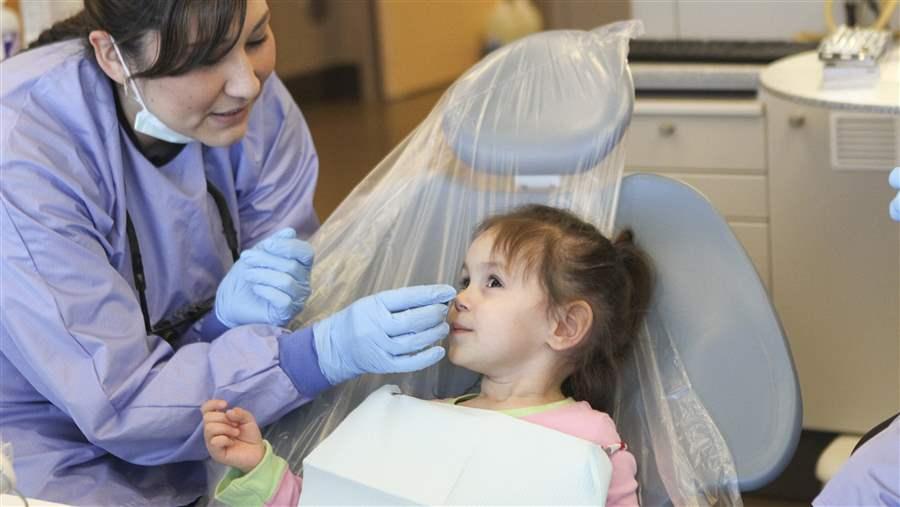Oregon Dental Pilot to Expand Tribes’ Access to Care
Midlevel providers to join clinic teams
 Alexis Matsui
Alexis MatsuiDental clinics serving two Oregon tribes have been authorized to hire dental health aide therapists to help expand care for their patients.
The Oregon Health Authority (OHA) on Feb. 8, 2016, approved a pilot that will allow health clinics and centers serving two tribes in the state—the Confederated Tribes of Coos, Lower Umpqua and Siuslaw Indians and the Coquille Indian Tribe—to hire dental therapists to help expand access to care.
The Northwest Portland Area Indian Health Board (NPAIHB) has partnered with the two tribes on the pilot, which is made possible by a 2011 Oregon law that supports innovative and data-driven improvements to the state’s oral health care system.
These midlevel providers will work under the supervision of a dentist to help respond to the unmet need for preventive and routine restorative care, such as filling cavities, placing temporary crowns, and extracting badly diseased or loose teeth.
The project marks the first time dental therapists will work in Oregon, but they are active elsewhere in the country—with a notable record of expanding access to care:
- The Oregon pilot replicates the highly successful dental therapy program in Alaska.
- Dentists in Minnesota have already integrated these providers into their practices.
- Maine authorized dentists to hire them in 2014.
- The Swinomish Indian Tribal Community in Washington state licensed and hired a dental therapist in January 2016.
Research from around the globe shows that dental therapists offer high-quality, cost-effective treatment, improving access especially in places where dentists are scarce.1 They receive two years of rigorous education and are required to have as much clinical experience as dentists for the limited number of procedures they perform. Further, a growing body of evidence demonstrates that they deliver safe and reliable care: More than 1,000 studies from across the globe found no quality concerns for these midlevel providers.2
Oregon tribal members served by the clinics that will hire dental therapists stand to benefit immensely. American Indians suffer from the poorest oral health of any population in the United States, with staggering rates of untreated tooth decay among children and of untreated decay and gum disease among adults.
If the pilot is successful and dentists statewide are allowed to hire similar providers, many more Oregonians could see their access to care improve. More than 1 million state residents live in areas with a shortage of dentists,3 and tooth decay is widespread. More than half of children ages 6-9 had decay in 2012, and 20 percent of children had dental caries that went untreated.4
Several other states are also considering legislation and additional proposals to authorize midlevel providers.
John Grant directs and Nate Myszka oversees state children’s dental policy campaigns at The Pew Charitable Trusts.
Endnotes
- Scott Wetterhall et al., “Evaluation of the Dental Health Aide Therapist Workforce Model in Alaska,” RTI International (2010), http://www.rti.org/pubs/alaskadhatprogramevaluationfinal102510.pdf; Frances Kim, “Economic Viability of Dental Therapists,” Community Catalyst (2013), http://www.communitycatalyst.org/doc-store/publications/economic-viability-dental-therapists.pdf; The Pew Charitable Trusts, “Expanding the Dental Team: Increasing Access to Care in Public Settings”(2014), http://www.pewtrusts.org/~ /media/assets /2014/06/27/expanding_dental_case_studies_report.pdf.
- David A. Nash et al., “A Review of the Global Literature on Dental Therapists,” W.K. Kellogg Foundation (2012), http://depts.washington.edu /dentexak/wordpress/wp-content/uploads/2012/10/Global-Literature.pdf; Minnesota Department of Health and Minnesota Board of Dentistry, “Early Impacts of Dental Therapists in Minnesota” (2014), http://www.health.state.mn.us/divs/orhpc/workforce/dt/dtlegisrpt.pdf; Scott Wetterhall et al., “Evaluation of the Dental Health Aide Therapist Workforce Model in Alaska.”
- U.S. Department of Health and Human Services, “Designated Health Professional Shortage Areas Statistics as of Jan. 1, 2016,” http://datawarehouse.hrsa.gov/Tools/quickreports.aspx.
- Oregon Health Authority, “Oregon Smile Survey 2012 Report,” https://public.health.oregon.gov/ PreventionWellness/oralhealth/Documents/SmileSurvey2012.pdf.






